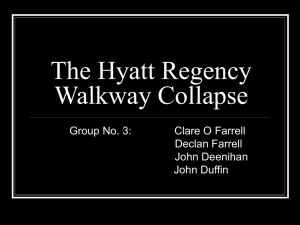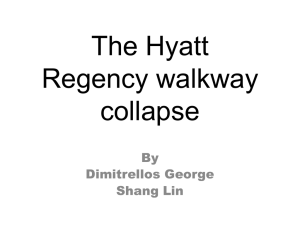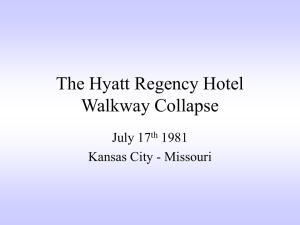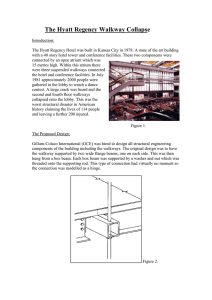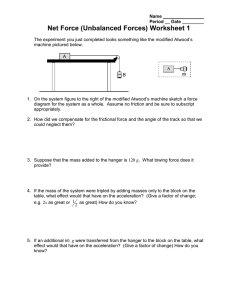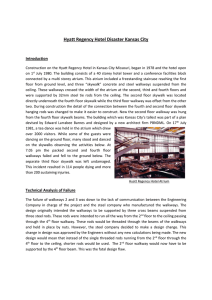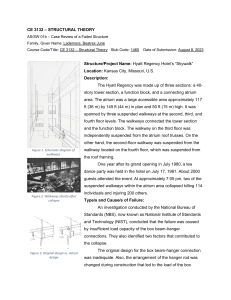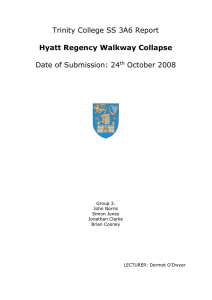Kansas City Hyatt Regency Walkway Collapse.ppt
advertisement
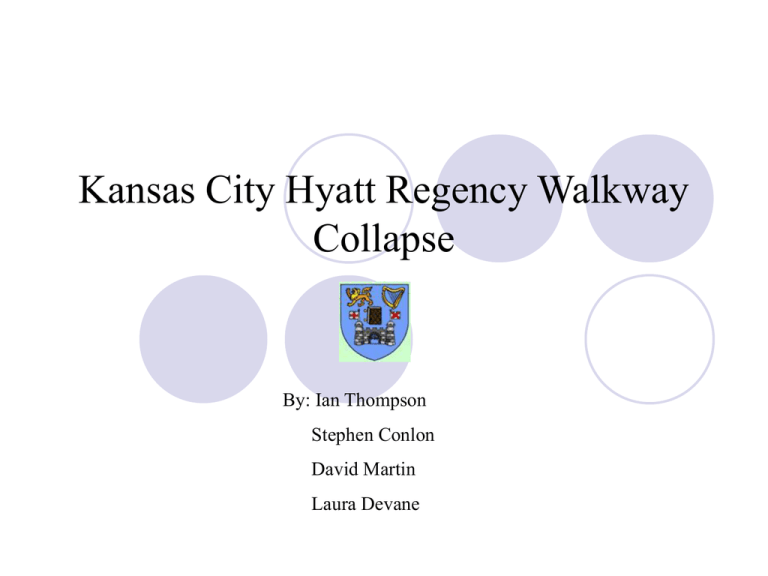
Kansas City Hyatt Regency Walkway Collapse By: Ian Thompson Stephen Conlon David Martin Laura Devane Design and Construction Opened to the public in 1980 after four years of design and construction Consisted of a 40-story tower, an atrium, a function block, and housing all of the hotel’s services Three walkways suspended from the atrium’s ceiling by six 32-mmdiameter tension rods, each spanned the 37-m distance between the tower and the function block The 2nd floor walkway suspended from the beams of the 4th floor walkway While the 3rd and 4th floor walkways hung from the ceiling Collapse • July 17, 1981, between 1500 and 2000 people inundated the atrium floor and the suspended walkways to see a local radio station’s dance competition • A loud crack echoed throughout the building and the 2nd and 4th floor walkways crashed to the ground • Killed 114 people and injured over 200 others • Worst structural failure in the history of the United State Causes of Failure Originally, 2nd and 4th floor walkways were to be suspended from the same rod and held in place by nuts (fig-1) Preliminary design specified a strength of 413 MPa for the hanger rods which was omitted on the final structural drawings Following the general notes in the absence of a specification on the drawing, the contractor used hanger rods with only 248 MPa of strength This original design, however, was highly impractical because it called for a nut 6.1 meters up the hanger rod and did not use sleeve nuts Contractor modified this detail to use 2 hanger rods instead of one (as shown in fig-2) and the engineer approved the design change without checking it. Design change doubled the stress on the nut under the fourth floor beam Nut supported the weight of 2 walkways instead of one Original(Fig.1) As-built(Fig.2) Causes of Failure Rod hanger pulled through the box beam causing the connection supporting the 4th floor walkway to fail Technical Concerns Neither the original nor the as-built design for the hanger rod satisfied the Kansas City building code making the connection failure inevitable The toe-to-toe channels used in the Hyatt Regency provided for weak welding which allowed the nut to pull through the channel/box beam assembly initiating the collapse A back-to-back channel design using web stiffeners when necessary (fig-3) or the use of bearing crossplates in conjunction with the toeto-toe channels (fig-4) would have made the connection much stronger making it much more difficult for the nut to pull through Fig-3 Fig-4 Procedural Concerns Collapse highlighted the lack of established procedures for design changes as well as the confusion over who is responsible for the integrity of shop details It is important for all parties to fully understand and accept their responsibilities in each project The engineer of record should design and detail all nonstandard connections New designs should be thoroughly checked All of the contractor's modifications to design details should require written approval from the engineer of record Conclusion Neglecting to check the safety and load capacity of a crucial hanger even once shows complete disregard for the public welfare Ethical engineers should check and recheck their work in order to be able to properly assure the public of a building's structural integrity Also, the high number of fatalities resulting from the walkway's collapse raises the questions of whether the factor of safety required for a building should be proportional to the possible consequences of it collapse
